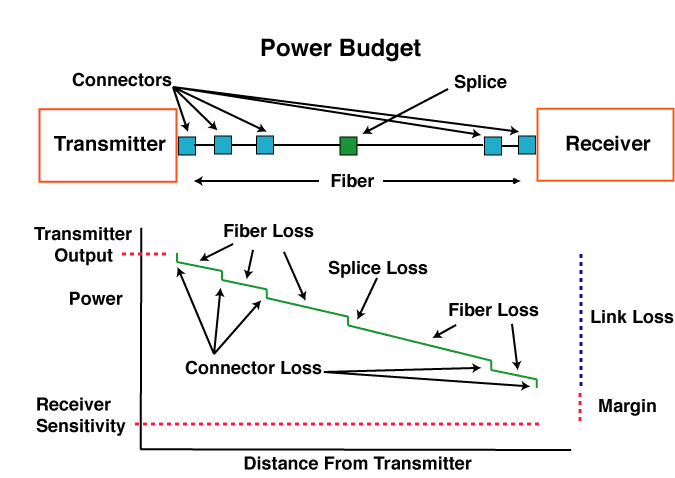Link Budget Evaluation Over SMF and MMF
Evaluating a link budget is equivalent to calculating the total loss suffered by a transmitted signal along fiber channels with the minimum receiver power to maintain normal operation. Calculating the link budget helps network architects to identify the feasibility of a physical-layer deployment.
Optical fibers come in several different configurations, each ideally suited to a different use or application. Early fiber designs that are still used today include single-mode fiber (SMF) and multimode fiber (MMF). And the most common optical communication data links include point-to-point transmission, WDM and amplified transmission. This article depicts the rules to be applied in order to evaluate link budget of these optical transmissions over SMF and MMF.
In this first case, the rule is fairly simple. A few parameters need to be taken into account:
● The minimum transmit power guaranteed (minTx), expressed in dB/m
● The minimum receive power required (minRx), expressed in dB/m
● The loss of optical connectors and adapters (L), expressed in dB
● The number of connectors and adapters (n)
● The normalized fiber loss (FL), expressed in dB/km
● The reach or distance to be achieved (d), expressed in km
With these parameters, the link budget (LB) expressed in dB is given as follows:
● (LB) = (minTx) – (minRx)
This value needs to be compared to the total loss (TL) suffered by the transmitted signal along the given link, and expressed in dB:
● (TL) = n*(L) + d*(FL)
If LB is greater than TL, then the physical deployment is theoretically possible.
In these calculations n is at least equal to 2 since there are a minimum of 2 connectors at each end, L is typically around 0.5 to 1 dB, and FL is of about 1 to 1.5 dB per km.
At first, you need to know that the lasers deployed in optical communications typically operate at or around 850 nm (first window), 1310 nm (second window), and 1550 nm (third and fourth windows). In this second case, the calculations are exactly similar to the previous case. Only the numerical values will differ. For single-mode point-to-point transmissions, n is at least equal to 2, L is typically around 0.3 to 0.5 dB, and FL is of about 0.4 dB per km in the second window and about 0.25 dB per km in the third window.
The following drawings show the power budget of a 2km hybrid multimode/singlemode link with 5 connections (2 connectors at each end and 3 connections at patch panels in the link) and one splice in the middle.

In the case of WDM transmissions, passive modules are used to multiplex and demultiplex various wavelengths respectively before and after the signal propagates along the fiber channel. These passive modules introduce additional insertion losses suffered by the signal transmitted.
Additionally, the signal may be amplified and compensated for dispersion, and in this case, the amplifier gain and the dispersion compensation unit's loss need to be taken into account. Dispersion and OSNR (optical signal over noise ratio) penalties suffered by the receiver shall be considered as well.
Therefore all the parameters needed for a proper link budget evaluation are:
● The minimum transmit power guaranteed (minTx), expressed in dB/m
● The minimum receive power required (minRx), expressed in dB/m
● The loss of optical connectors and adapters (L), expressed in dB
● The number of connectors and adapters (n)
● The normalized fiber loss (FL), expressed in dB/km
● The reach or distance to be achieved (d), expressed in km
● The loss of passive add/drop modules (A and D), expressed in dB
● The gain of the amplifier (G), expressed in dB
● The penalty suffered by the receiver (P), expressed in dB
● The loss of a dispersion compensation unit (DCU), expressed in dB With these parameters, (LB) is given as for previous cases:
● (LB) = (minTx) – (minRx)
And the total loss is expressed as follows:
● (TL) = n*(L) + d*(FL) + (A) + (D) – (G) + (DCU) + (P)
Here again, if LB is greater than TL, then the physical deployment is feasible. Please note that for simplicity, only one amplifier, one dispersion compensation unit, and one set of add/drop modules are considered in this example. If more devices are planned to be deployed, their loss or gain should be added or subtracted accordingly in order to calculate TL.
Link budget is a way of quantifying the link performance. And the performance of any communication link depends on the quality of the equipment being used. Thus, when evaluating a link budget, you are supposed to consider the types of applications, the reach to be achieved, as well as the types of optical fibers deployed. For more information about fiber optical link products, please visit FS.COM.
Originally published at www.fiber-optic-equipment.com/link-budget-evaluation-over-smf-and-mmf.html

Comments